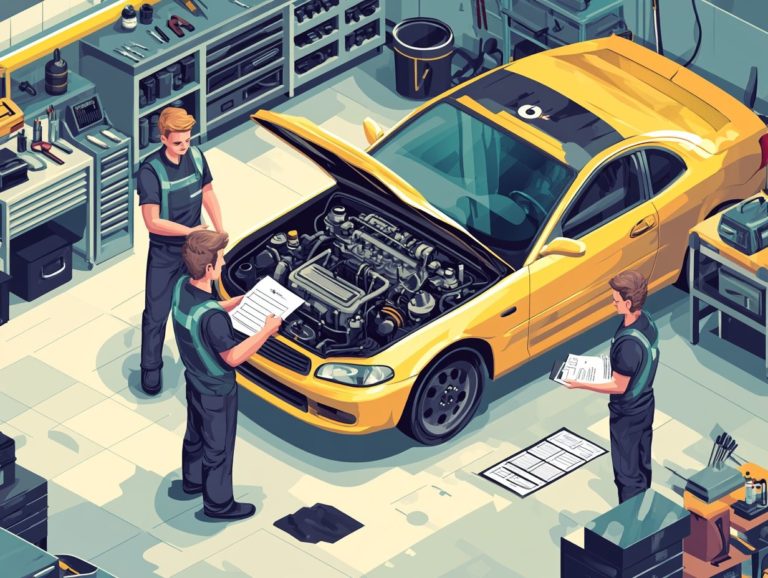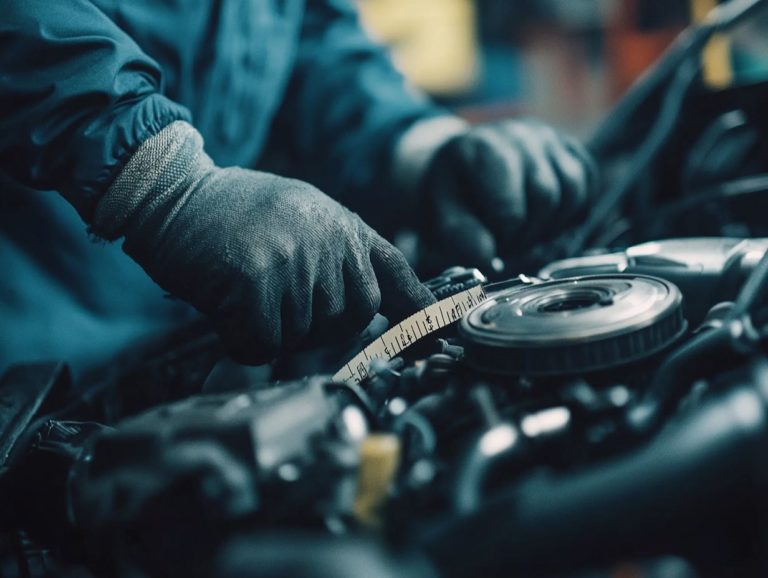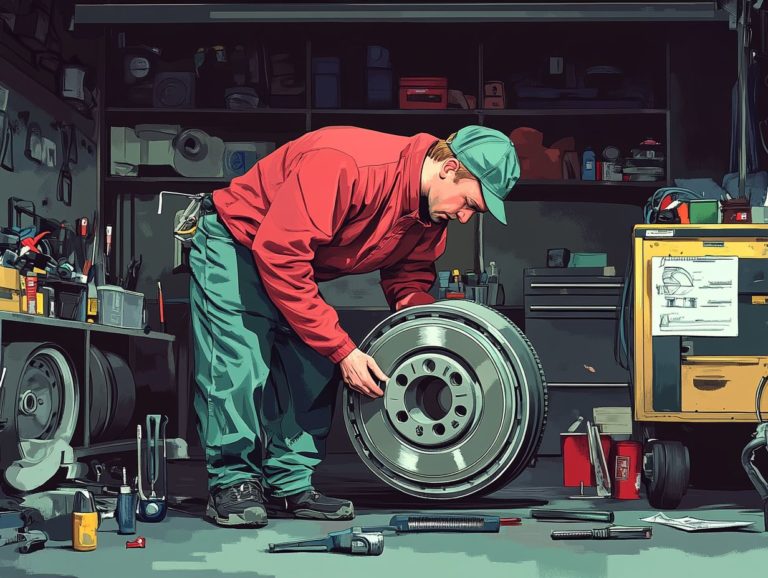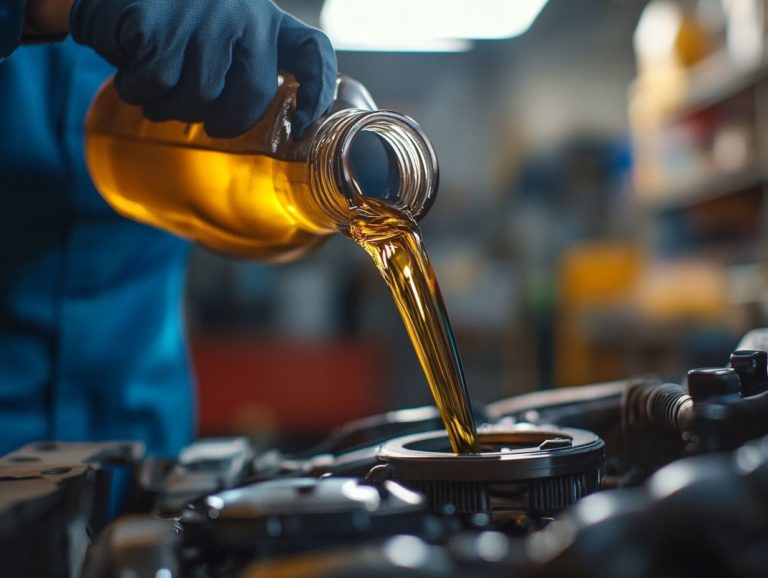What Should You Check During a DIY Oil Change?
Changing your own oil can be a fulfilling way to save money and deepen your understanding of your vehicle. While the benefits are enticing, it s important to recognize the risks if you’re not adequately prepared.
This guide provides everything you need for a successful DIY oil change, from essential tools to a step-by-step process, along with vital checks to enhance your car’s performance. It will also spotlight common pitfalls to steer clear of, empowering you to tackle this maintenance task with confidence.
Are you excited to get started?
Contents
Key Takeaways:
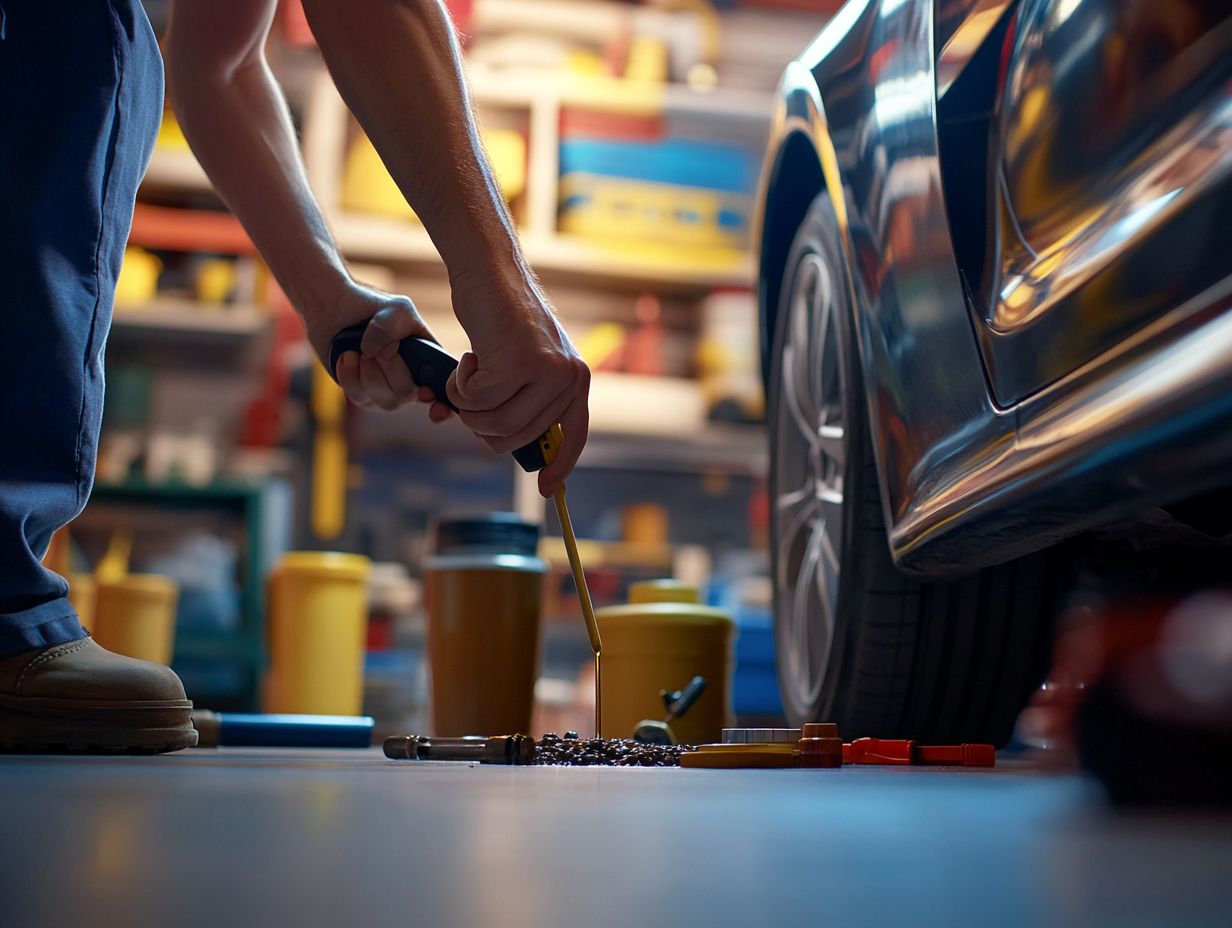
- Remember to gather all necessary tools and supplies before starting a DIY oil change to ensure a smooth process.
- Regularly checking and changing your oil is crucial for optimal performance and longevity of your vehicle.
- Inspecting key components such as the oil filter, drain plug, and oil levels during an oil change can prevent costly errors and improve overall vehicle health.
Why DIY Oil Changes Are a Game-Changer for Car Owners
Undertaking a DIY oil change can be an incredibly rewarding experience, providing a range of benefits that include significant cost savings, enhanced time efficiency, and the chance to develop self-reliance in basic car maintenance. You’ll not only sidestep those hefty service fees typically charged at places like Walmart or auto parts stores, but you can also create lasting memories with family while imparting essential skills.
This is especially valuable for new car lovers who relish hands-on tasks and the satisfaction of taking care of their vehicle.
Essential Tools and Supplies
To execute a successful DIY oil change, you must first gather the essential tools and supplies that will guarantee a smooth and safe experience. Key items for this task include:
- You will need an oil filter wrench.
- You will need an oil drain plug to facilitate the process.
- You will need jack stands for secure lifting.
- You will need wheel chocks to prevent any rolling.
Don t forget your personal protective gear safety goggles and rubber gloves are crucial. A funnel and a wide-mouth container for the old oil are also essential for proper collection and disposal.
What You’ll Need for a Successful Oil Change
To ensure a successful oil change, you ll want to gather the right tools and supplies. This includes a funnel for easy pouring, a dipstick for checking oil levels, and a solid understanding of your car’s oil capacity, which refers to how much oil your car needs to run properly.
The funnel is your best friend here, preventing spills and making the transfer of oil into the engine both smooth and efficient. The dipstick is equally important; it allows you to keep tabs on oil levels, helping you determine when an oil change is due or if a top-off is necessary.
In terms of different car makes, knowing the oil capacity is crucial. For example, Mazda models often have a lower oil capacity compared to some Hyundai models, while Volvo vehicles may require a specific type of oil altogether.
To check the dipstick accurately, make sure the engine is cool and level. Wipe the dipstick clean, then reinsert and remove it to check the oil level against the markings. Regular monitoring will go a long way in maintaining your engine’s health and performance.
Step-by-Step Guide to Changing Your Oil
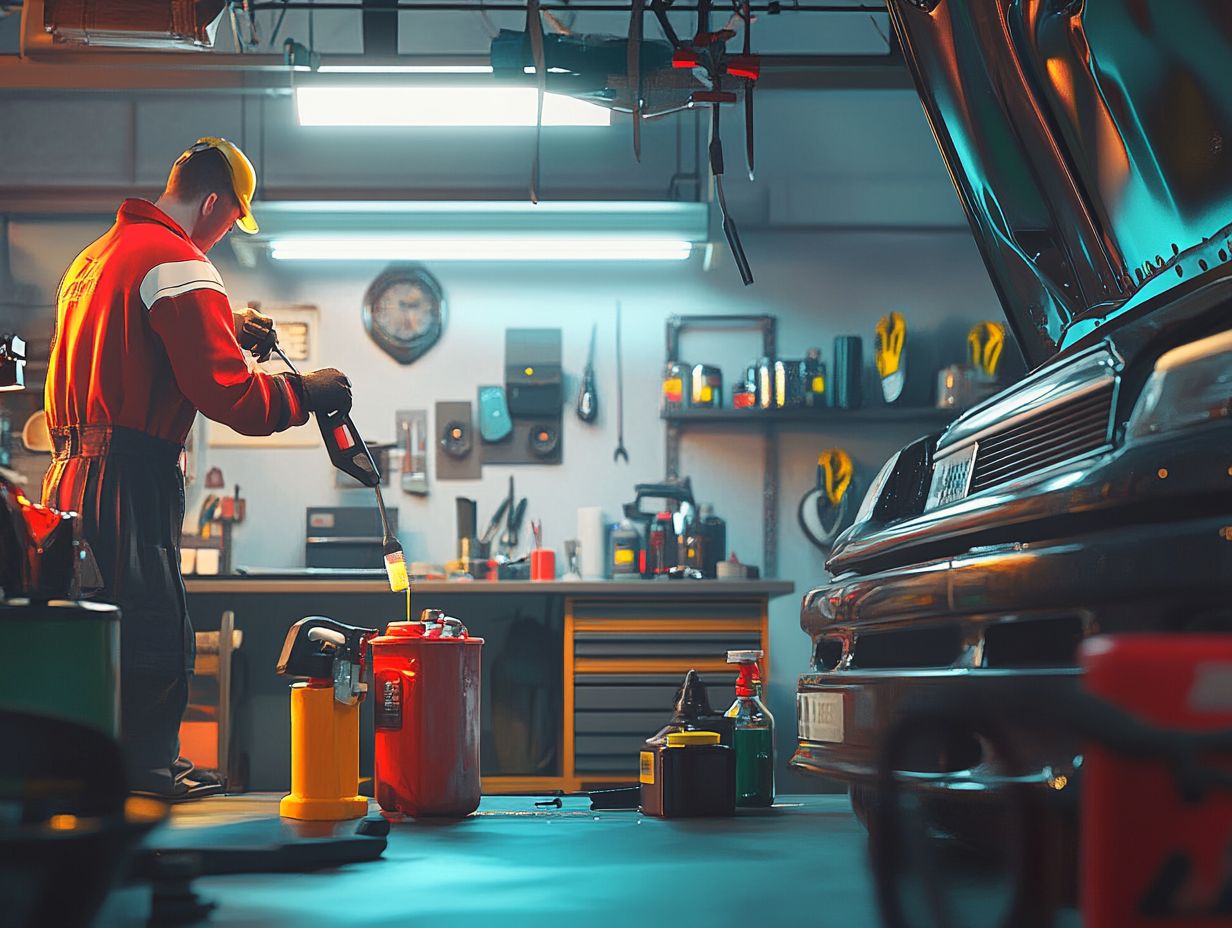
Changing your oil isn’t as intimidating as it may seem. With a straightforward step-by-step guide, you can confidently tackle the DIY oil change process. Begin by gathering all your supplies and putting on your safety gear. Then, follow the detailed instructions that meticulously outline each phase starting with draining the old oil, replacing the oil filter, adding fresh oil, and finally checking the levels with the dipstick.
Dive in, and enjoy the rewarding experience of changing your oil!
Detailed Instructions for a Smooth Process
Follow these steps closely for a hassle-free oil change experience! It s vital to know detailed instructions that guide you through every stage. This includes the proper techniques for removing the oil drain plug and replacing the oil filter. Familiarizing yourself with each step helps prevent mishaps and keeps your car running at its best.
Begin by gathering the essential tools:
- An adjustable wrench
- A new oil filter
- Fresh oil
- A drain pan
Remember, safety comes first, so be sure to wear gloves and safety goggles.
When you’re ready to kick off the oil change, make sure your vehicle is parked on a stable surface and has cooled down. Then, using the adjustable wrench, carefully loosen the oil drain plug. It s crucial to turn it counterclockwise; if it proves resistant, a light tap can help break the seal.
Position the drain pan beneath the plug to catch the old oil as it drains completely. Next, locate the oil filter, usually situated near the oil pan. Use an oil filter wrench to unscrew it, angling the filter to minimize spills.
By following these methods, you not only ensure a clean process but also extend the longevity of your engine.
How Often Should You Change Your Oil?
Understanding the ideal frequency for changing your oil is essential for ensuring your vehicle operates at its best. Several factors come into play, including your car’s oil capacity, your driving habits, and the type of oil you choose.
Generally speaking, synthetic oils, which are man-made, tend to have a longer lifespan than conventional oils. It’s vital to consider these elements when setting your oil change schedule. Prioritizing this maintenance can significantly enhance your car’s performance and longevity.
Factors to Consider for Oil Change Frequency
When determining how often you should change your oil, several key factors come into play. Consider your driving conditions, the make of your vehicle, and the type of oil you’re using. If you often make short trips, you might need to change your oil more frequently than someone who primarily drives on highways.
This is mainly because those short jaunts can prevent your engine from reaching its optimal temperature, allowing harmful deposits and sludge to accumulate. Plus, navigating stop-and-go traffic adds extra stress to your engine, hastening oil breakdown.
Weather conditions also impact your oil change frequency; extreme temperatures can affect the thickness of your oil and its ability to protect your engine. While many vehicle manufacturers provide guidelines based on these factors, it’s crucial that you tailor those recommendations to fit your driving habits.
Synthetic oils often offer superior protection and allow for longer intervals between changes, making them an excellent choice if you frequently face challenging driving conditions. By grasping these nuances, you can significantly enhance your engine’s performance and longevity.
What to Check During an Oil Change

During an oil change, it s crucial to check several key components that play a vital role in your vehicle’s optimal performance. Start by looking at the oil level with the dipstick, and don t overlook the condition of the oil filter.
These checks are essential to ensure that your engine operates s smoothly and efficiently, keeping your vehicle in prime condition.
Key Components to Inspect for Optimal Performance
When you re conducting an oil change, here are a few key components to check for optimal performance:
- The oil filter
- The oil level
- The condition of the oil
Each of these plays a vital role in ensuring that your engine operates efficiently. Start with the oil filter. Look for any signs of clogs or damage, as these can impede the flow of oil and lead to unwanted engine wear. Next, use the dipstick to check the oil level it s crucial. Low oil levels might indicate leaks or excessive consumption, while high levels could suggest a potential coolant leak.
Don t overlook the oil’s condition. Look for any discoloration or gritty texture, which can signal contamination and the urgent need for replacement. By paying attention to these details, you can maintain your engine s health and enhance your vehicle s overall performance.
By regularly changing your oil, you re investing in the longevity and performance of your vehicle!
Common Mistakes to Avoid
Avoiding common mistakes is essential for a successful DIY oil change. Many first-timers stumble into errors that could lead to costly repairs or even dangerous situations.
By understanding and recognizing these pitfalls, you can ensure a smooth and safe oil change experience. This will make the process both effective and stress-free.
Tips for Avoiding Costly Errors
To steer clear of costly mistakes during your DIY oil change, prepare thoroughly. Gather all the necessary tools and supplies, and double-check your oil capacity before diving in. This thoughtful preparation can save you both time and money.
Having the right tools at your fingertips like a wrench, oil filter, and a drain pan will significantly streamline the process. Remember, safety should always come first. Wear gloves and goggles to protect yourself from spills or splashes.
Ensure your vehicle is parked on a level surface and secured with wheel chocks to prevent any unintended movement. By taking these precautions and confirming that you have the proper oil type and quantity, you can execute a smooth oil change while minimizing the risk of errors.
Frequently Asked Questions

What Should You Check During a DIY Oil Change?
During a DIY oil change, checking the level and condition of your oil, the oil filter, drain plug, and overall vehicle condition is crucial!
How do I check the oil level and condition?
To check the oil level, make sure your vehicle is on a level surface. Use the dipstick to see where the oil level falls. To check the condition, rub a small amount of oil between your fingers to look for dirt or discoloration.
Why is it important to check the oil filter?
The oil filter removes dirt and debris from the oil. Make sure it is not clogged or damaged. Replace it to ensure clean oil circulates through your engine!
How do I check the drain plug?
The drain plug allows you to drain the old oil from your vehicle. Before starting, make sure the drain plug is secure and not leaking. After draining the oil, tighten the plug back in place.
What should I look out for during the oil change process?
While changing your oil, keep an eye out for any leaks, unusual sounds, or changes in oil color. These could signal a larger issue with your vehicle that needs attention.
What other areas of my vehicle should I check during an oil change?
During an oil change, check the coolant level, brake fluid, and windshield wiper fluid. This is also a great opportunity to inspect your vehicle’s overall condition and note any potential maintenance needs.


